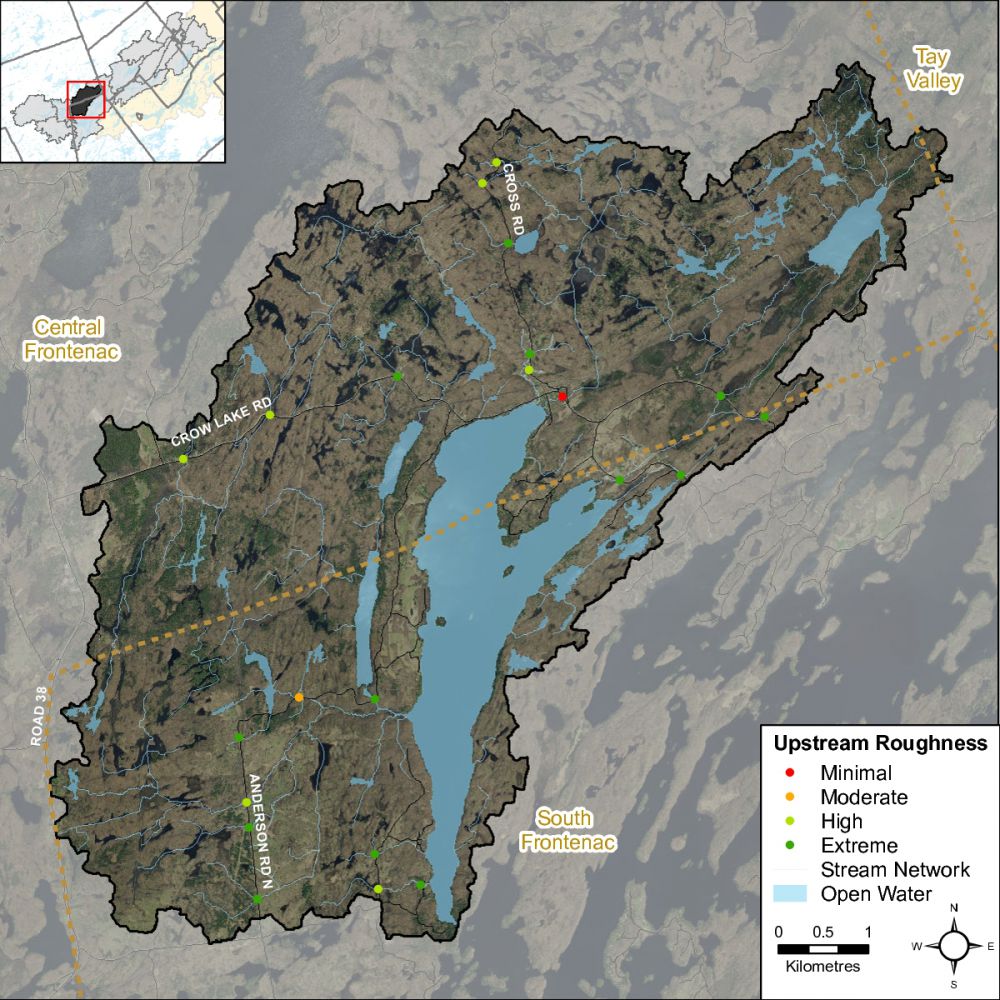3.0 Bobs and Crow Lake Catchments: Riparian Conditions
3.1 Bobs Lake: Aquatic Habitat
3.1.1 Groundwater
Groundwater discharge areas can influence stream temperature, contribute nutrients, and provide important stream habitat for fish and other biota. During stream surveys, indicators of groundwater discharge are noted when observed. Indicators include: springs/seeps, watercress, iron staining, significant temperature change and rainbow mineral film. Figure 100 shows areas where one or more of the above groundwater indicators were observed during headwater assessments.
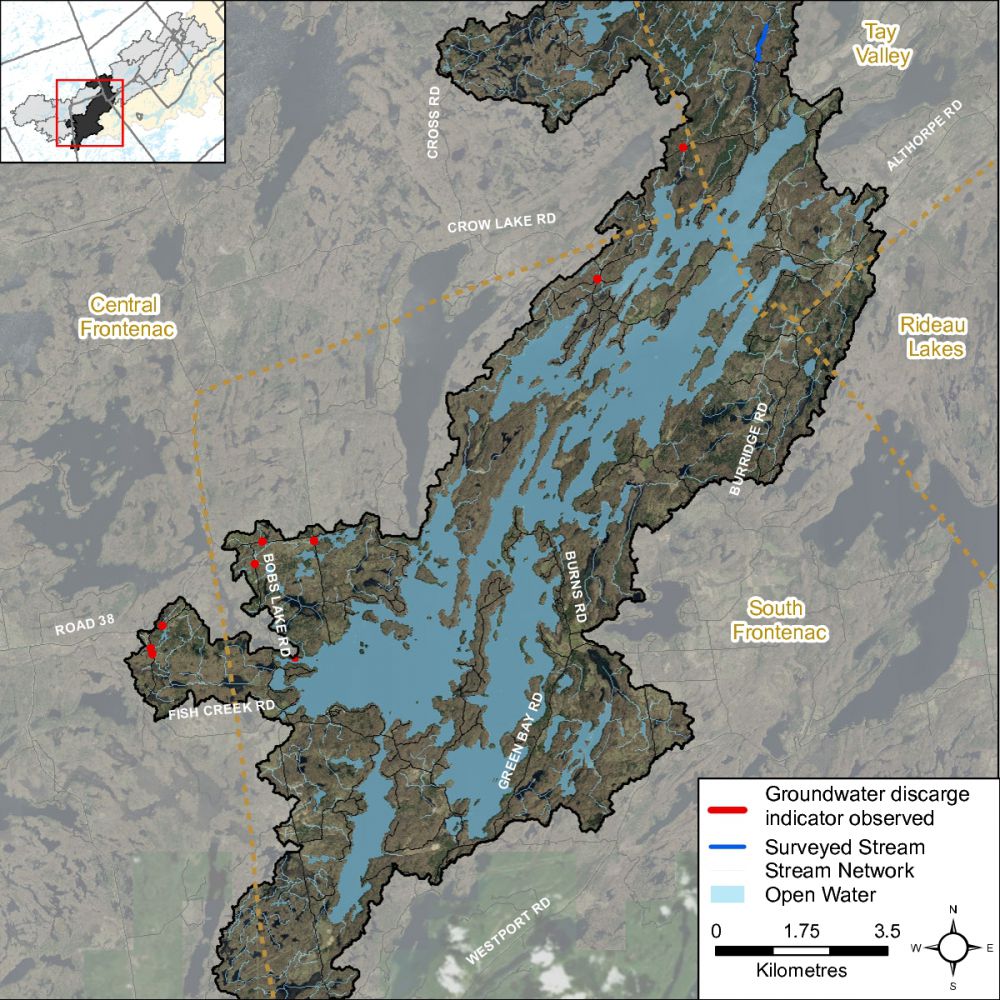
3.1.2 Fish Community
The Bobs Lake catchment is classified as a mixed community of warm and cool water recreational and baitfish fishery (Figure 101). The fish community has not been sampled extensively in the Bobs Lake catchment.
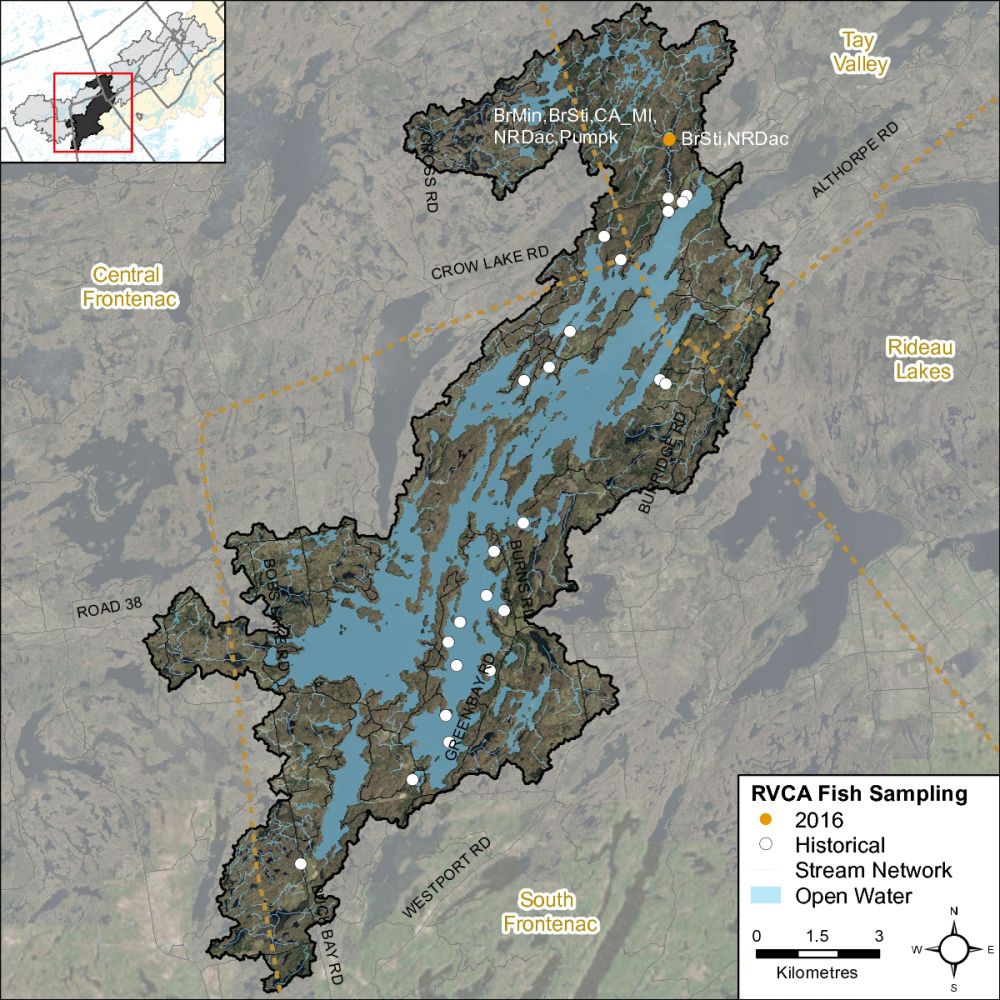
Table 43 contains a list of species observed in the watershed.
| Fish Species | Scientific Name | Fish code | Historical | 2016 |
|---|---|---|---|---|
| bluntnose minnow | Pimephales notatus | BnMin | X | |
| brassy minnow | Hybognathus hankinsoni | BrMin | X | |
| brook stickleback | Culaea inconstans | BrSti | X | X |
| brown bullhead | Ameiurus nebulosus | BrBul | X | |
| carps and minnows | Cyprinidae | CA_MI | X | |
| common shiner | Luxilus cornutus | CoShi | X | |
| creek chub | Semotilus atromaculatus | CrChu | X | |
| fallfish | Semotilus corporalis | Fallf | X | |
| fathead minnow | Pimephales promelas | FhMin | X | |
| finescale dace | Phoxinus neogaeus | FsDac | X | |
| iowa darter | Etheostoma exile | IoDar | X | |
| lake trout | Salvelinus namaycush | LaTro | X | |
| largemouth bass | Micropterus salmoides | LmBas | X | |
| logperch | Percina caprodes | Logpe | X | |
| micropterus sp. | Micropterus sp. | MicSp | X | |
| northern pike | Esox lucius | NoPik | X | |
| northern redbelly dace | Chrosomus eos | NRDac | X | |
| pumpkinseed | Lepomis gibbosus | Pumpk | X | X |
| rock bass | Ambloplites rupestris | RoBas | X | |
| smallmouth bass | Micropterus dolomieu | SmBas | X | |
| walleye | Sander vitreus | Walle | X | |
| white sucker | Catostomus commersonii | WhSuc | X | |
| yellow bullhead | Ameiurus natalis | YeBul | X | |
| yellow perch | Perca flavescens | YePer | X | |
| TOTAL Species | 21 | 5 |
3.1.3 Migratory Obstructions
Migratory obstructions represent limitations to fish dispersal within a system and may restrict access to important spawning and rearing habitat. Migratory obstructions can be natural or manmade, and they can be permanent or seasonal. Figure 102 shows that the Bobs Lake catchment area had eight perched culverts and one dam at the time of the survey in 2016.
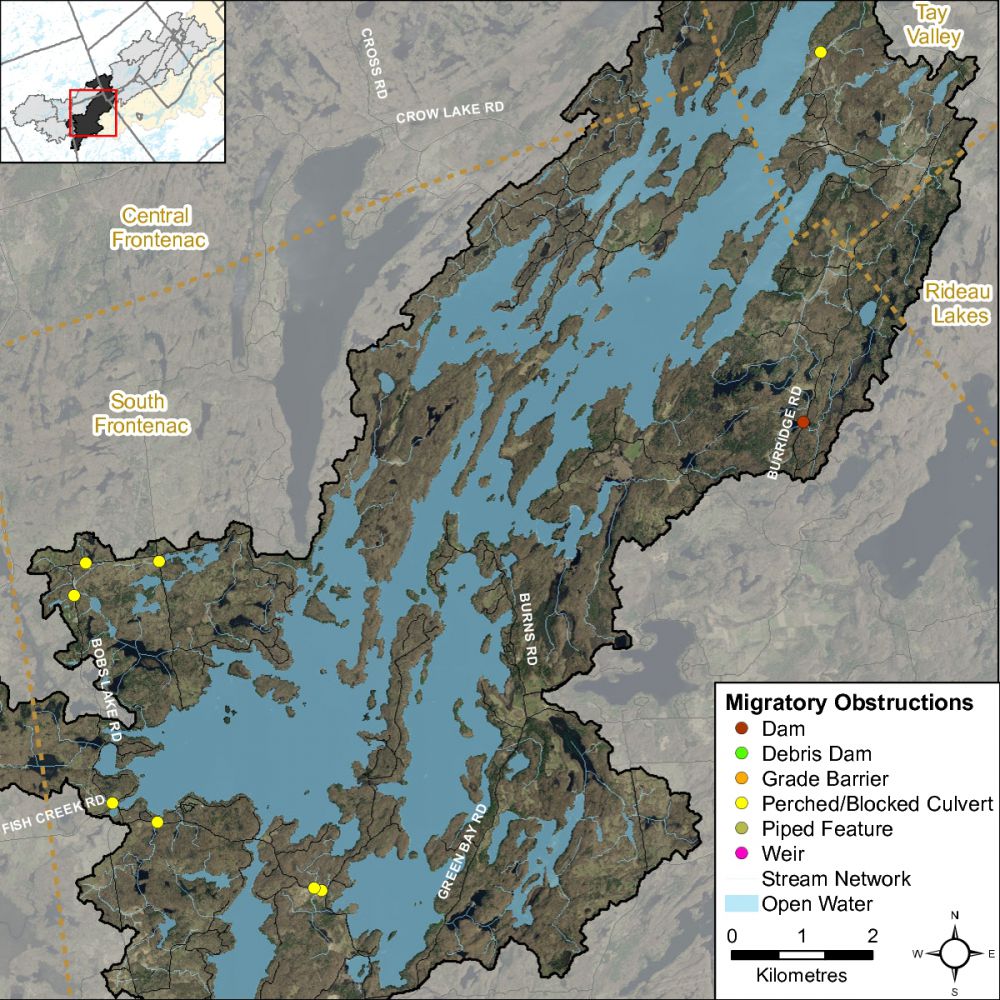
3.1.4 Riparian Restoration
Figure 103 depicts the locations of various riparian restoration opportunities as a result of observations made during the headwater drainage feature surveys.
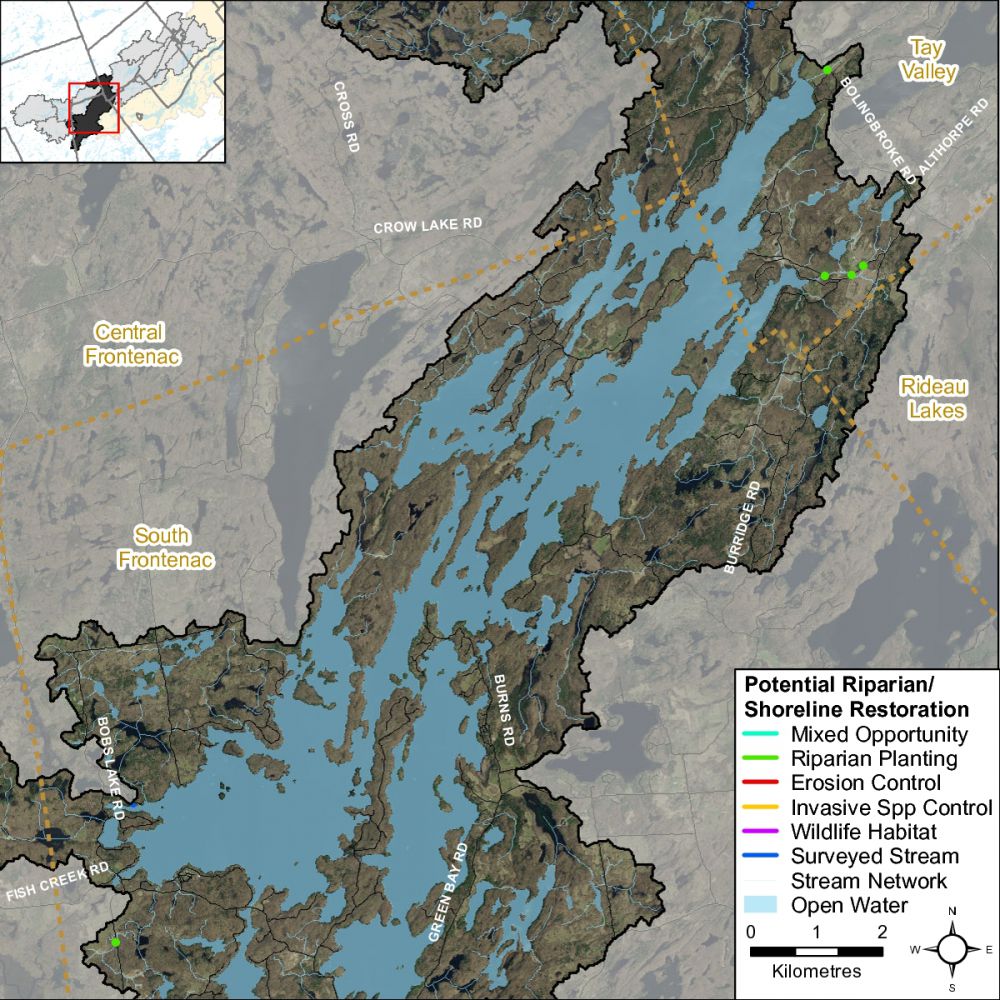
3.2 Bobs Lake Catchment: Headwater Drainage Feature Assessment
3.2.1 Headwaters Sampling Locations
The RVCA Stream Characterization program assessed Headwater Drainage Features for the Bobs Lake catchment in 2016. This protocol measures zero, first and second order headwater drainage features (HDF). It is a rapid assessment method characterizing the amount of water, sediment transport, and storage capacity within headwater drainage features (HDF). RVCA is working with other Conservation Authorities and the Ministry of Natural Resources and Forestry to implement the protocol with the goal of providing standard datasets to support science development and monitoring of headwater drainage features. An HDF is a depression in the land that conveys surface flow. Additionally, this module provides a means of characterizing the connectivity, form and unique features associated with each HDF (OSAP Protocol, 2013). In 2016 the program sampled 39 sites at road crossings in the Bobs Lake catchment area (Figure 104).
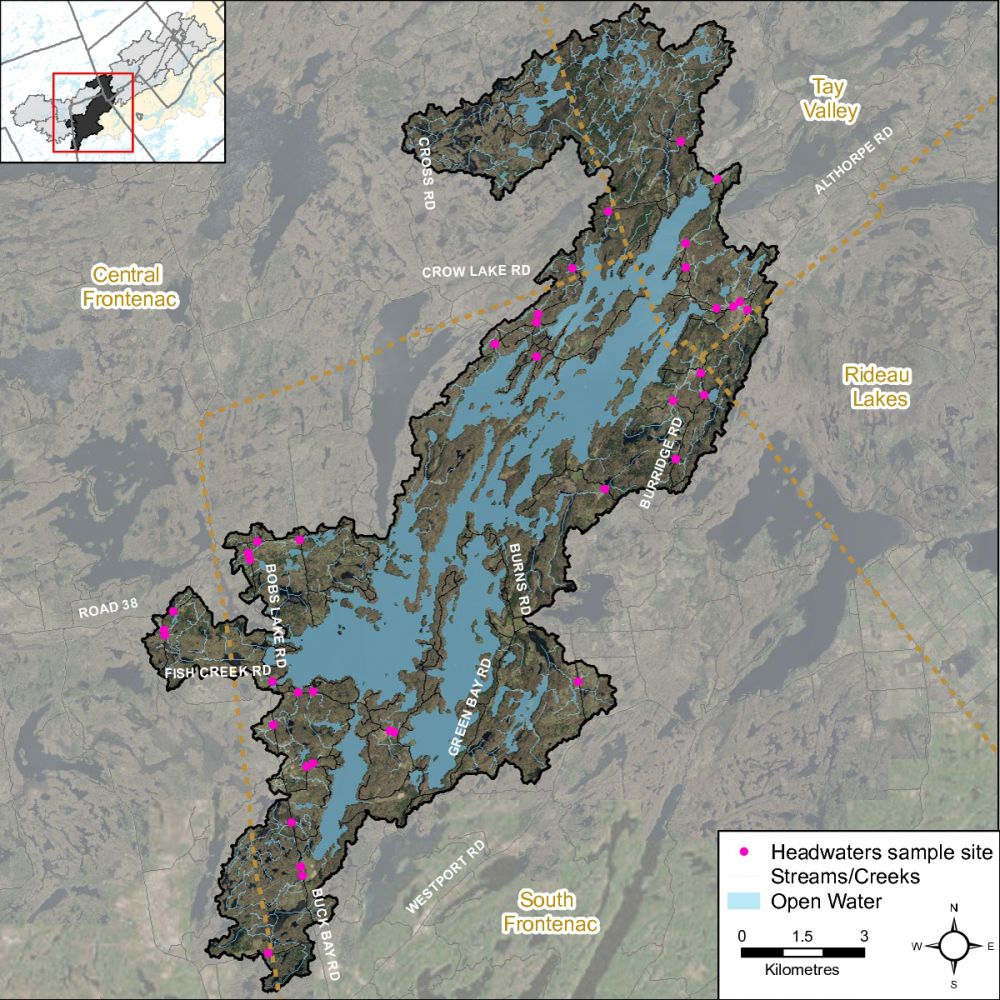
3.2.2 Headwater Feature Type
The headwater sampling protocol assesses the feature type in order to understand the function of each feature. The evaluation includes the following classifications: defined natural channel, channelized or constrained, multi-thread, no defined feature, tiled, wetland, swale, roadside ditch and pond outlet. By assessing the values associated with the headwater drainage features in the catchment area we can understand the ecosystem services that they provide to the watershed in the form of hydrology, sediment transport, and aquatic and terrestrial functions. The headwater drainage features in the Bobs Lake catchment are predominantly natural and wetland features. Figure 105 shows the feature type of the primary feature at the sampling locations.
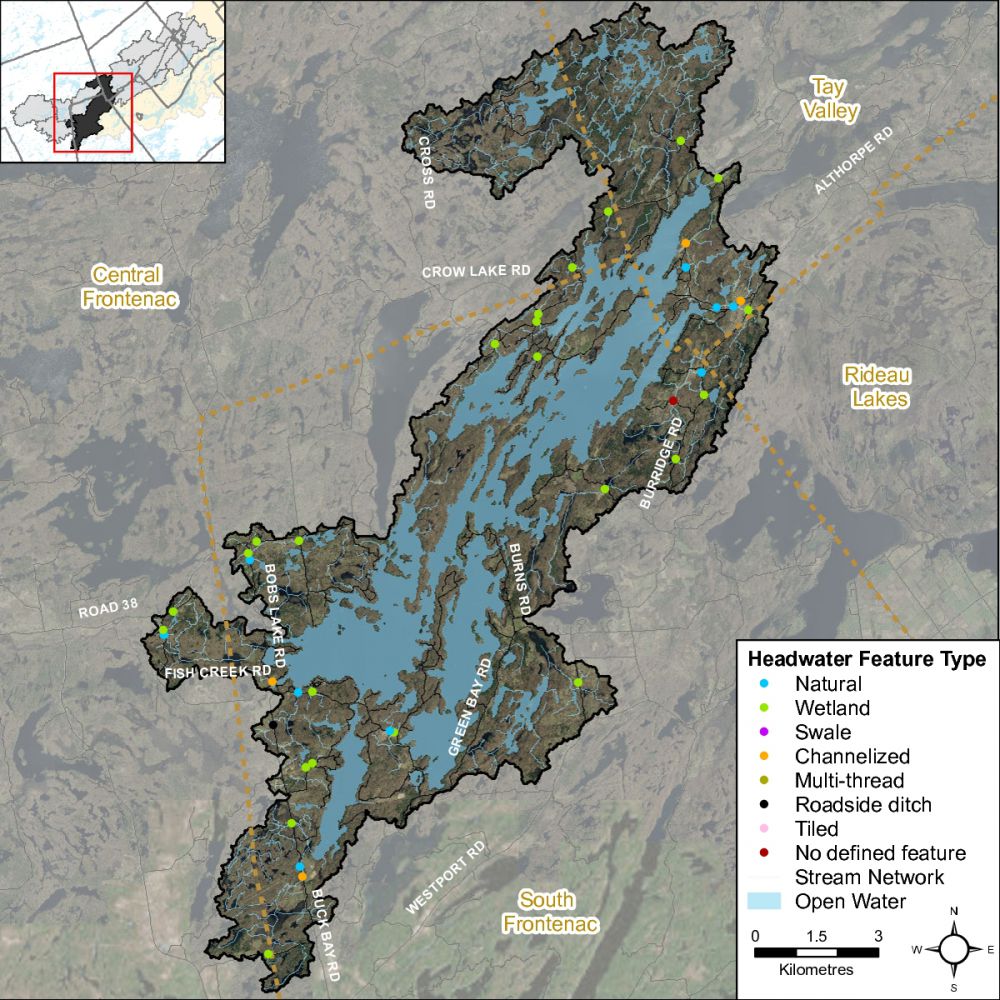
3.2.3 Headwater Feature Flow
The observed flow condition within headwater drainage features can be highly variable depending on timing relative to the spring freshet, recent rainfall, soil moisture, etc. Flow conditions are assessed in the spring and in the summer to determine if features are perennial and flow year round, if they are intermittent and dry up during the summer months or if they are ephemeral systems that do not flow regularly and generally respond to specific rainstorm events or snowmelt. Flow conditions in headwater systems can change from year to year depending on local precipitation patterns. Figure 106 shows the observed flow condition at the sampling locations in the Bobs Lake catchment in 2016.
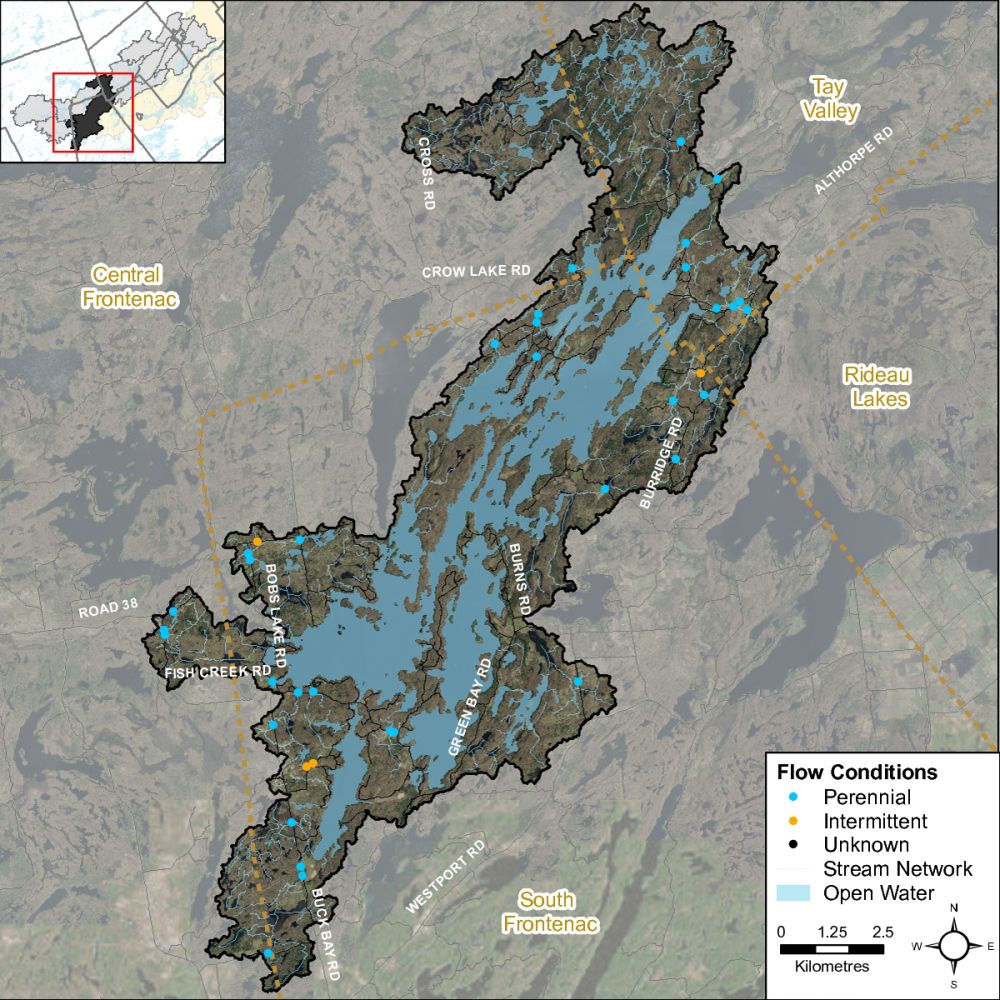
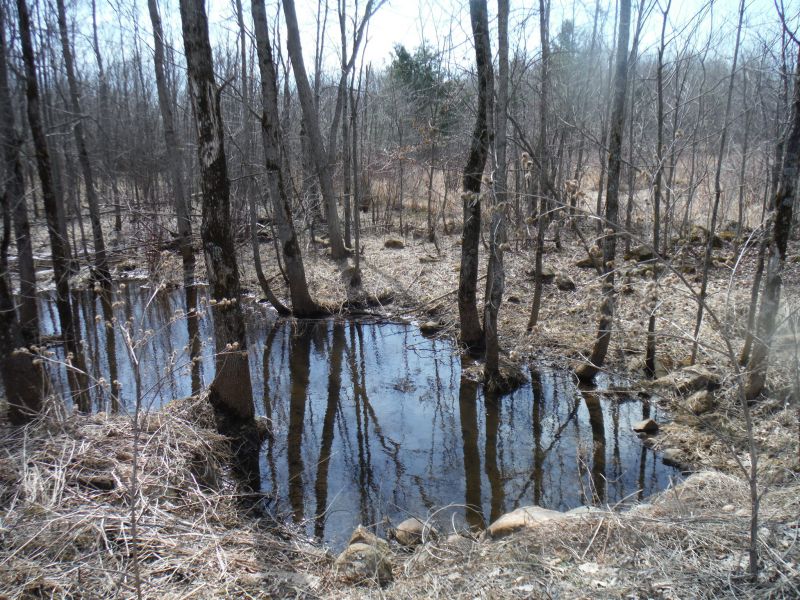
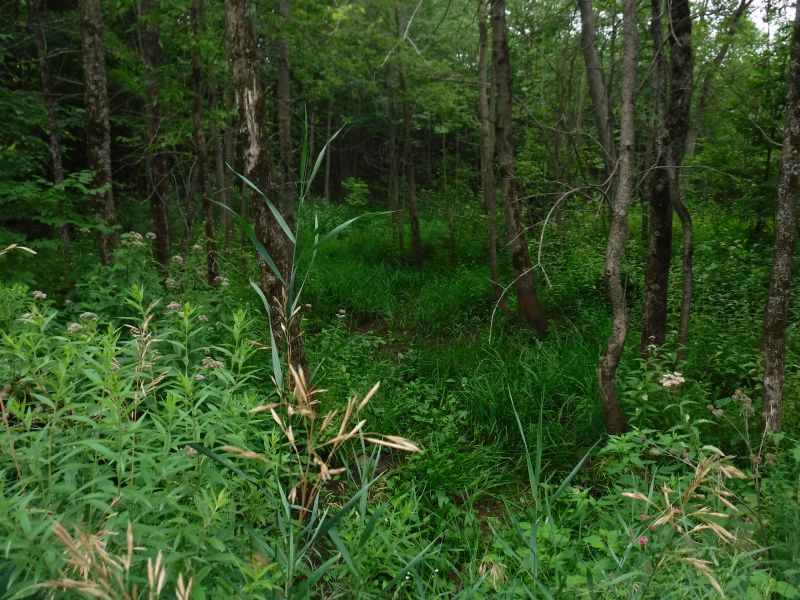
3.2.4 Feature Channel Modifications
Channel modifications were assessed at each headwater drainage feature sampling location. Modifications include channelization, dredging, hardening and realignments. The Bobs Lake catchment area had a majority of features with no channel modifications observed, two locations had mixed modifications and six had been historically dredged or channelized. Figure 107 shows the channel modifications observed at the sampling locations for the Bobs Lake catchment.
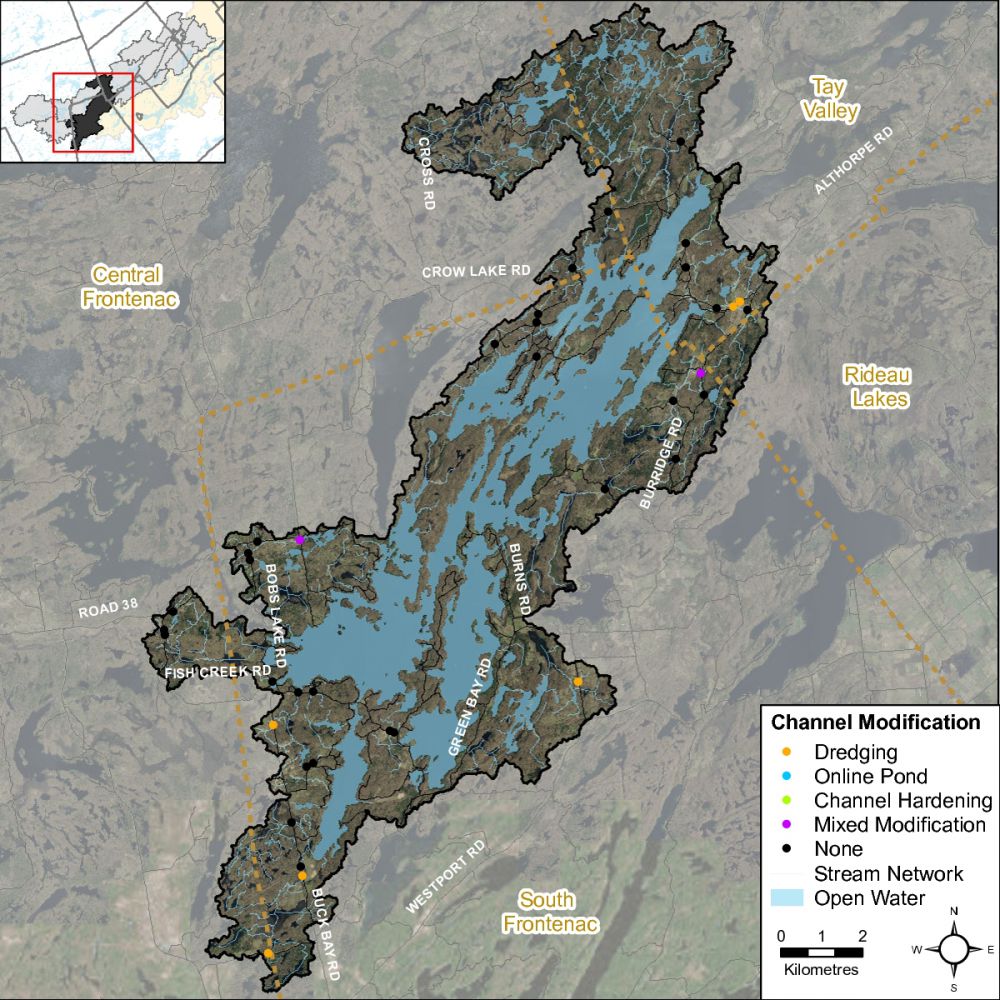
3.2.5 Headwater Feature Vegetation
Headwater feature vegetation evaluates the type of vegetation that is found within the drainage feature. The type of vegetation within the channel influences the aquatic and terrestrial ecosystem values that the feature provides. For some types of headwater features the vegetation within the feature plays a very important role in flow and sediment movement and provides wildlife habitat. The following classifications are evaluated no vegetation, lawn, wetland, meadow, scrubland and forest. Figure 108 depicts the dominant vegetation observed at the sampled headwater sites in the Bobs Lake catchment.
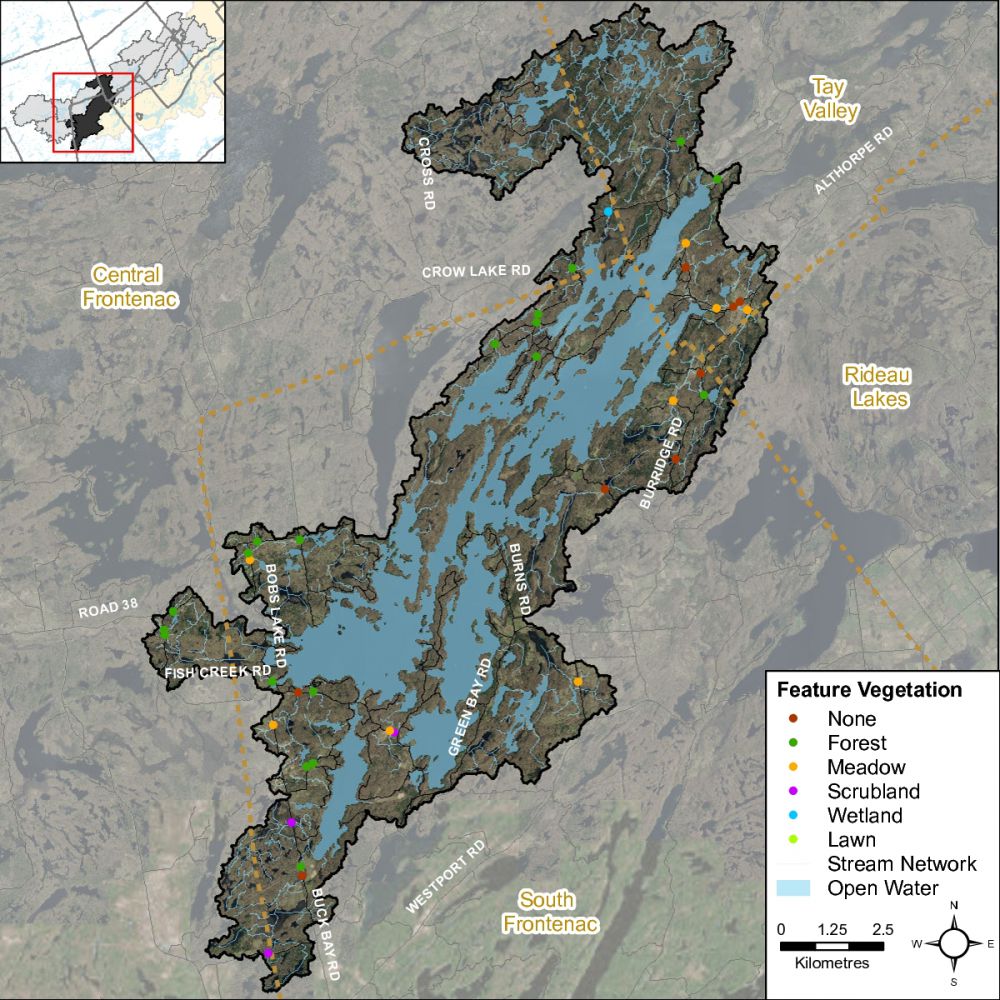
3.2.6 Headwater Feature Riparian Vegetation
Headwater riparian vegetation evaluates the type of vegetation that is found along the adjacent lands of a headwater drainage feature. The type of vegetation within the riparian corridor influences the aquatic and terrestrial ecosystem values that the feature provides to the watershed. Figure 109 depicts the type of riparian vegetation observed at the sampled headwater sites in the Bobs Lake catchment. The majority of the headwater drainage features are classified as having natural riparian vegetation with eleven features having altered vegetation.
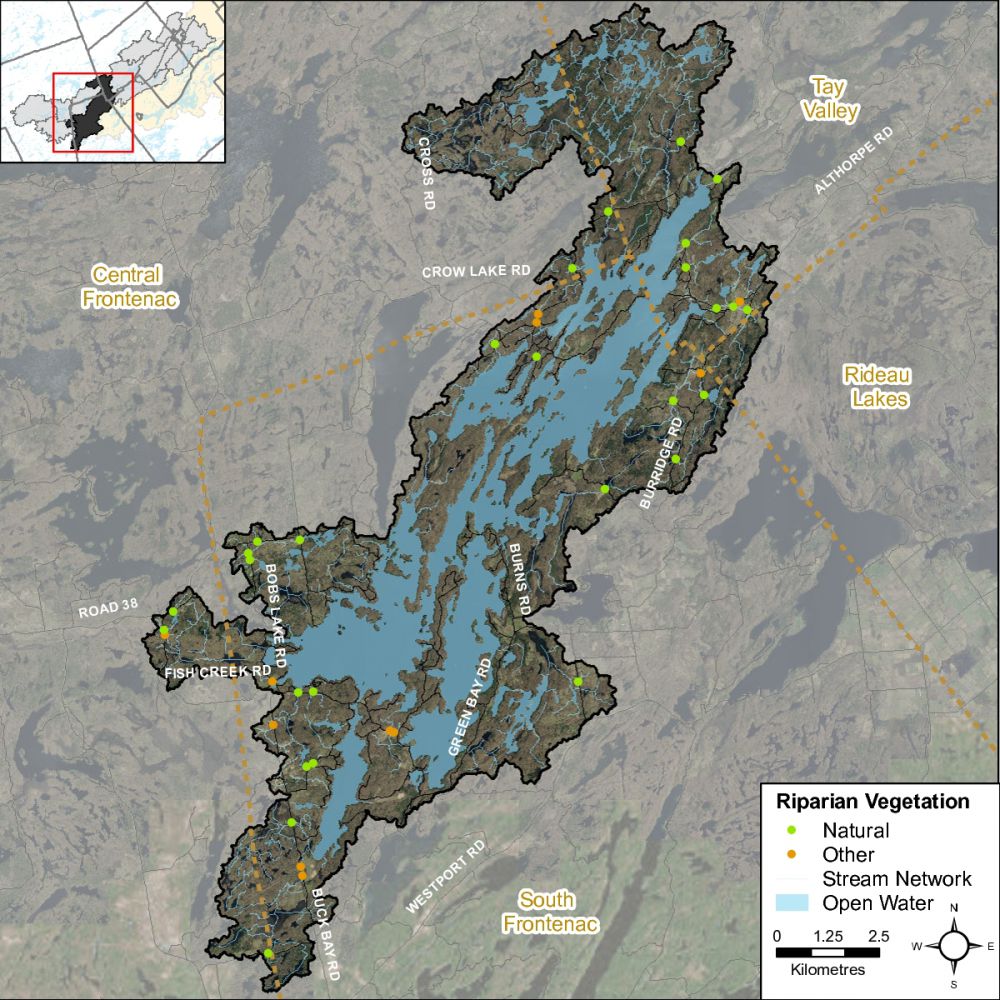
3.2.7 Headwater Feature Sediment Deposition
Assessing the amount of recent sediment deposited in a channel provides an index of the degree to which the feature could be transporting sediment to downstream reaches (OSAP, 2013). Evidence of excessive sediment deposition might indicate the requirement to follow up with more detailed targeted assessments upstream of the site location to identify potential best management practices to be implemented. Sediment deposition ranged from none to substantial for the headwater sites sampled in the Bobs Lake catchment area. Figure 110 depicts the degree of sediment deposition observed at the sampled headwater sites in the Bobs Lake catchment. Sediment deposition conditions ranged from no sediment deposition to substantial levels of deposition.
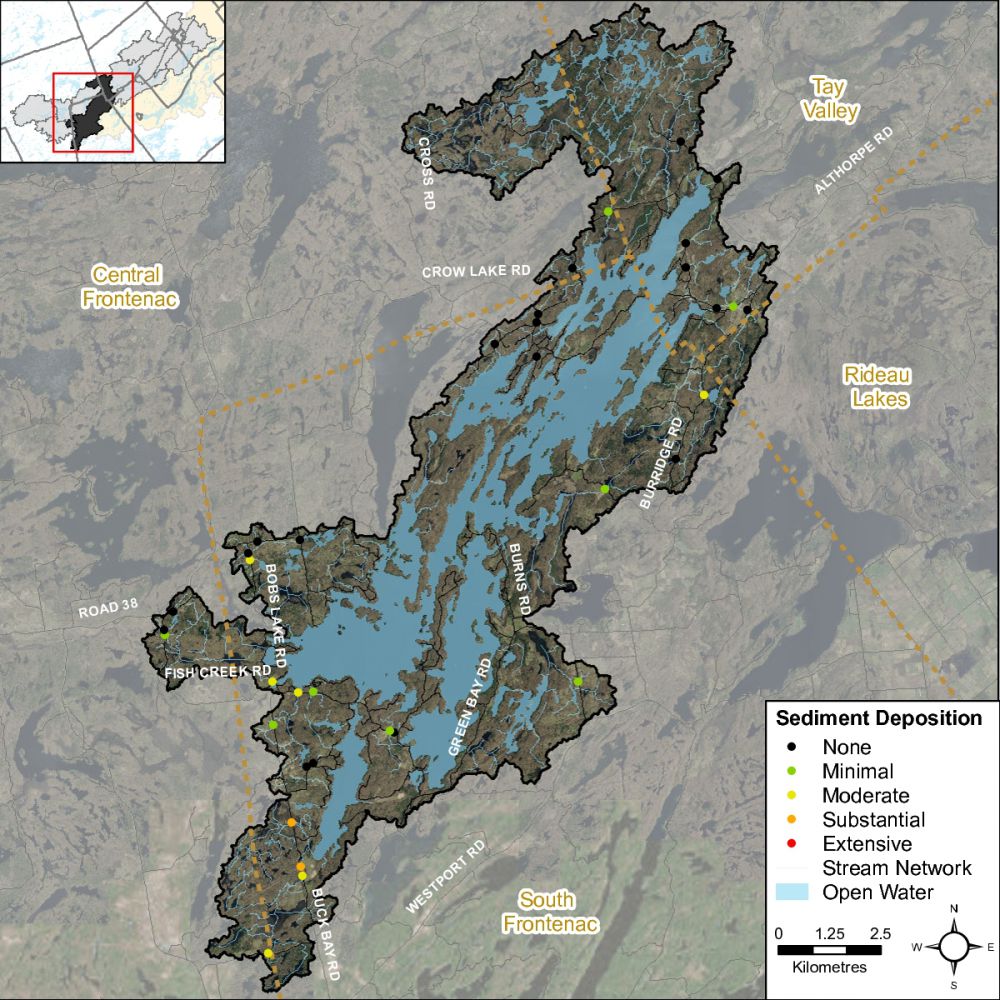
3.2.8 Headwater Feature Upstream Roughness
Feature roughness will provide a measure of the amount of materials within the bankfull channel that could slow down the velocity of water flowing within the headwater feature (OSAP, 2013). Materials on the channel bottom that provide roughness include vegetation, woody Structure and boulders/cobble substrates. Roughness can provide benefits in mitigating downstream erosion on the headwater drainage feature and the receiving watercourse by reducing velocities. Roughness also provides important habitat conditions for aquatic organisms. Figure 111 shows that the feature roughness conditions at the sampling locations in the Bobs Lake catchment were highly variable ranging from minimal to extreme roughness conditions.
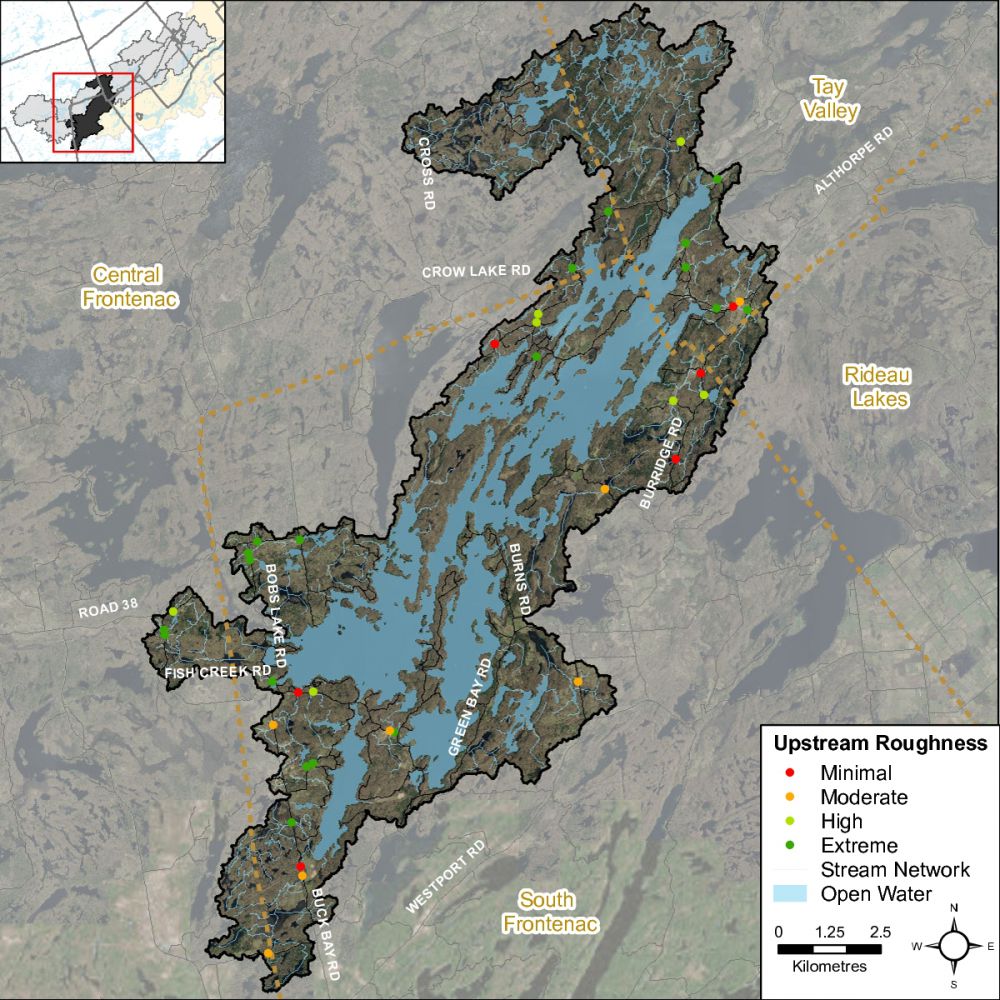
3.3 Crow Lake Catchment: Headwater Drainage Features Assessment
3.3.1 Headwater Sampling Locations
The RVCA Stream Characterization program assessed Headwater Drainage Features for the Crow Lake catchment in 2016. This protocol measures zero, first and second order headwater drainage features (HDF). It is a rapid assessment method characterizing the amount of water, sediment transport, and storage capacity within headwater drainage features (HDF). RVCA is working with other Conservation Authorities and the Ministry of Natural Resources and Forestry to implement the protocol with the goal of providing standard datasets to support science development and monitoring of headwater drainage features. An HDF is a depression in the land that conveys surface flow. Additionally, this module provides a means of characterizing the connectivity, form and unique features associated with each HDF (OSAP Protocol, 2013). In 2016 the program sampled 22 sites at road crossings in the Crow Lake catchment area (Figure 112).
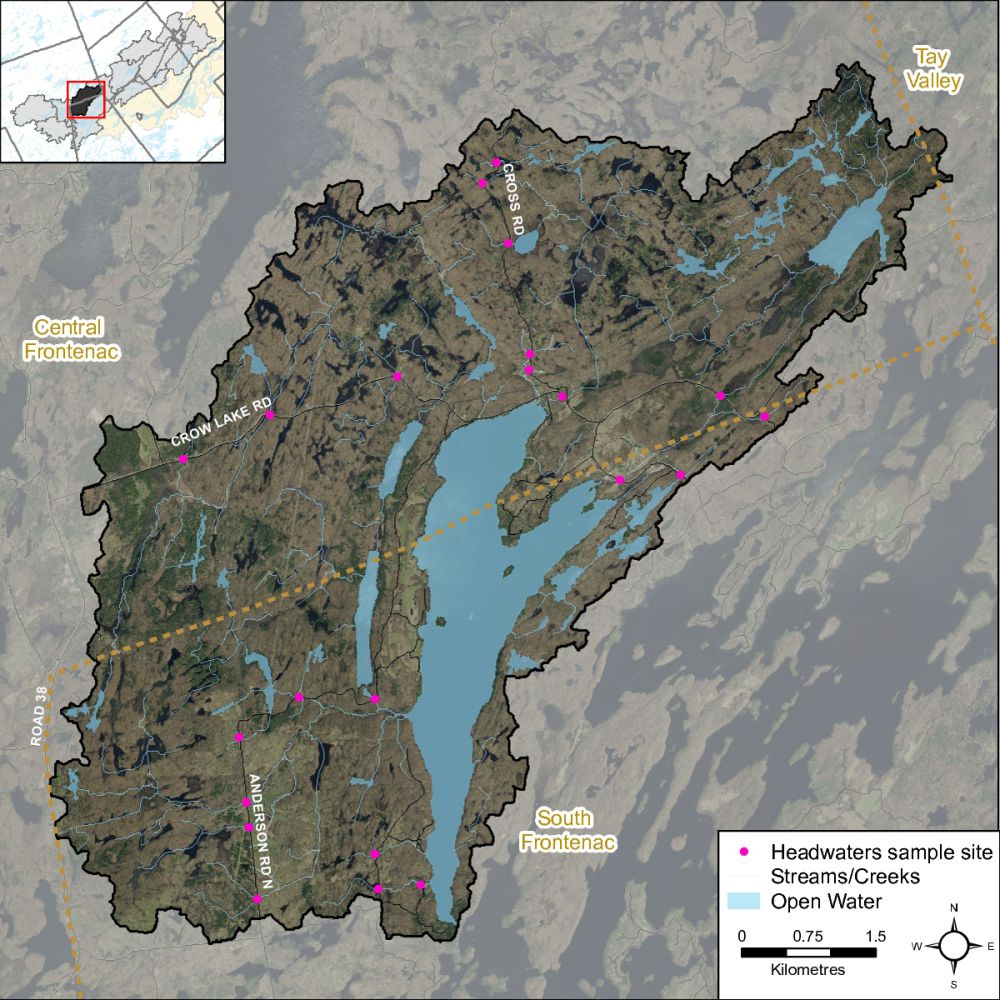
3.3.2 Headwater Feature Type
The headwater sampling protocol assesses the feature type in order to understand the function of each feature. The evaluation includes the following classifications: defined natural channel, channelized or constrained, multi-thread, no defined feature, tiled, wetland, swale, roadside ditch and pond outlet. By assessing the values associated with the headwater drainage features in the catchment area we can understand the ecosystem services that they provide to the watershed in the form of hydrology, sediment transport, and aquatic and terrestrial functions. The headwater drainage features in the Crow Lake catchment are predominantly natural and wetland features. Figure 113 shows the feature type of the primary feature at the sampling locations.
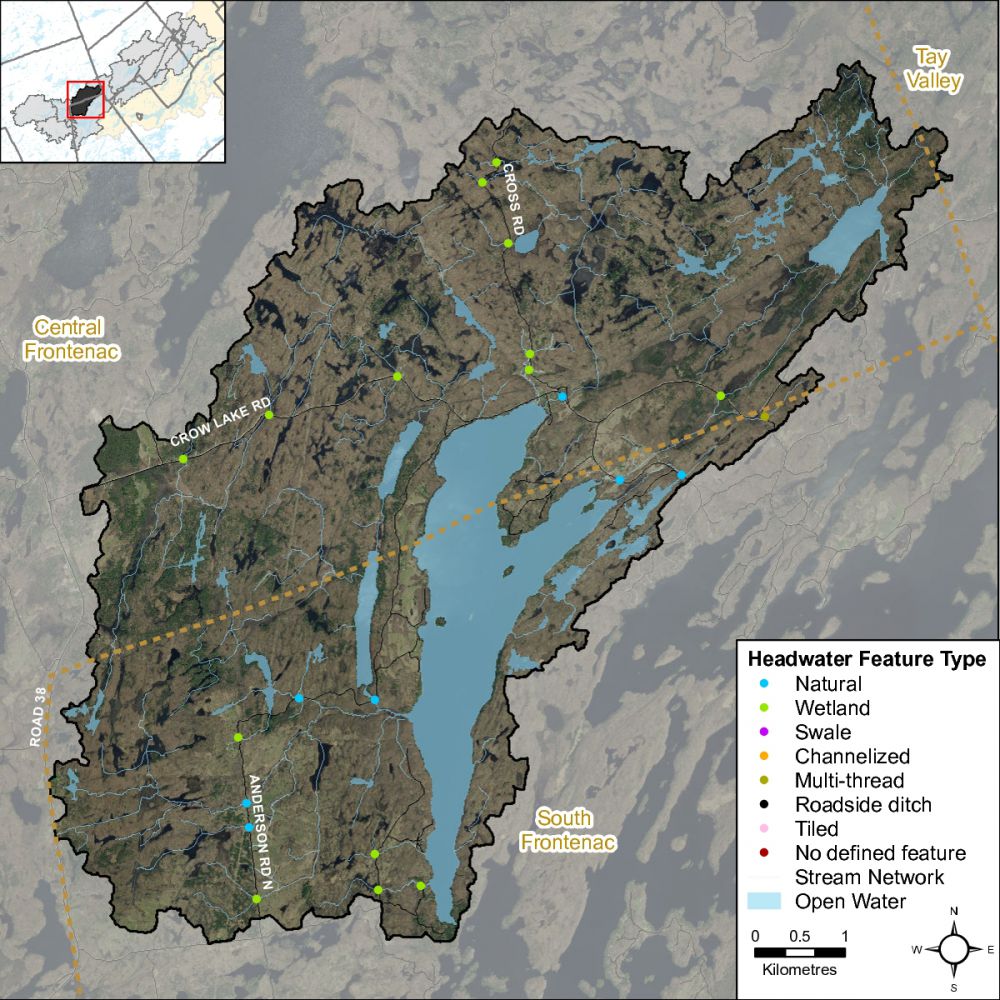
3.3.3 Headwater Feature Flow
The observed flow condition within headwater drainage features can be highly variable depending on timing relative to the spring freshet, recent rainfall, soil moisture, etc. Flow conditions are assessed in the spring and in the summer to determine if features are perennial and flow year round, if they are intermittent and dry up during the summer months or if they are ephemeral systems that do not flow regularly and generally respond to specific rainstorm events or snowmelt. Flow conditions in headwater systems can change from year to year depending on local precipitation patterns. Figure 114 shows the observed flow condition at the sampling locations in the Crow Lake catchment in 2016.
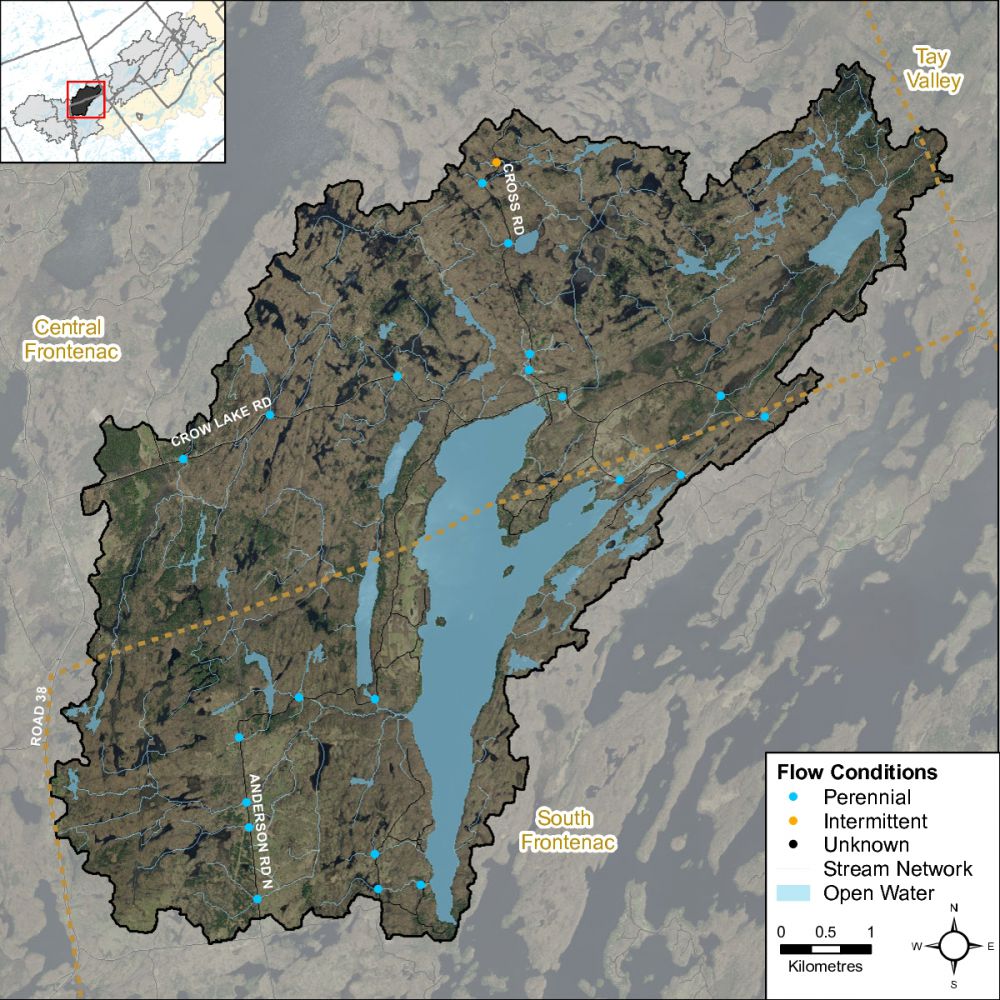
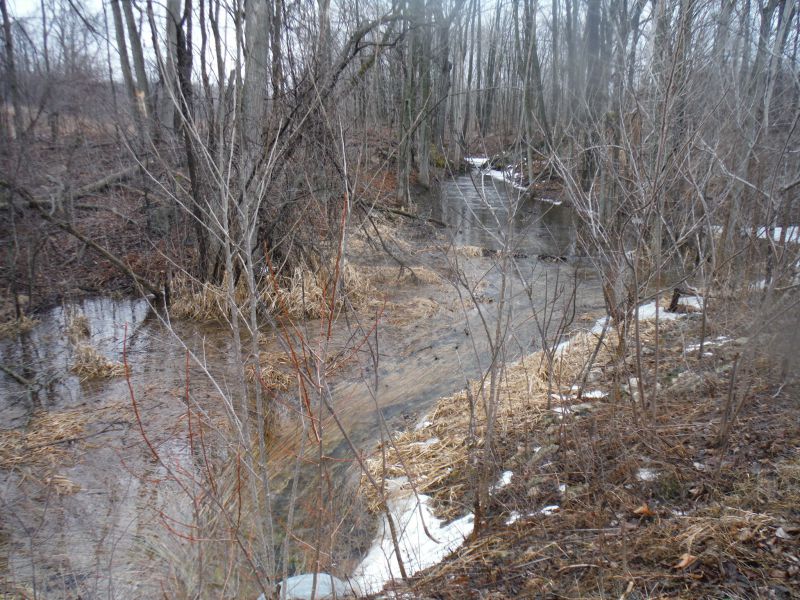
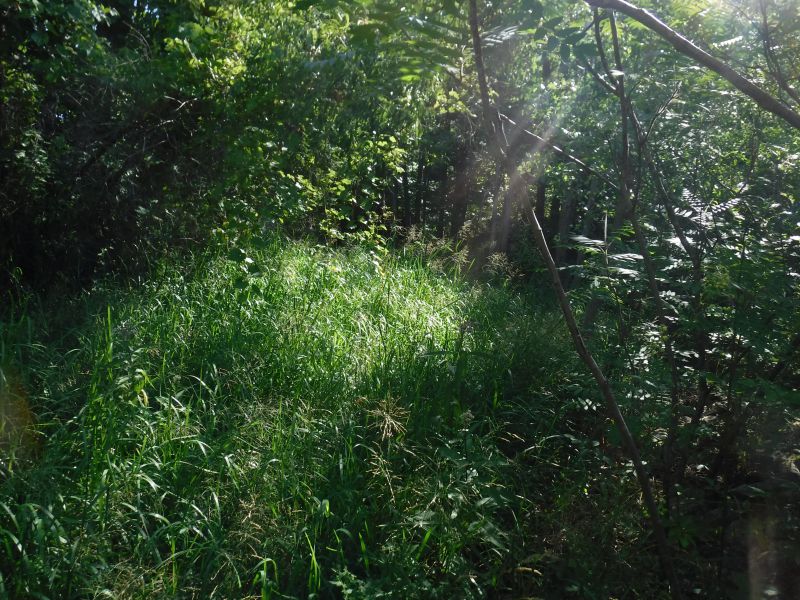
3.3.4 Headwater Feature Channel Modifications
Channel modifications were assessed at each headwater drainage feature sampling location. Modifications include channelization, dredging, hardening and realignments. The Crow Lake catchment area had a majority of features with no channel modifications observed, only one location had mixed modifications. Figure 115 shows the channel modifications observed at the sampling locations for the Crow Lake catchment.
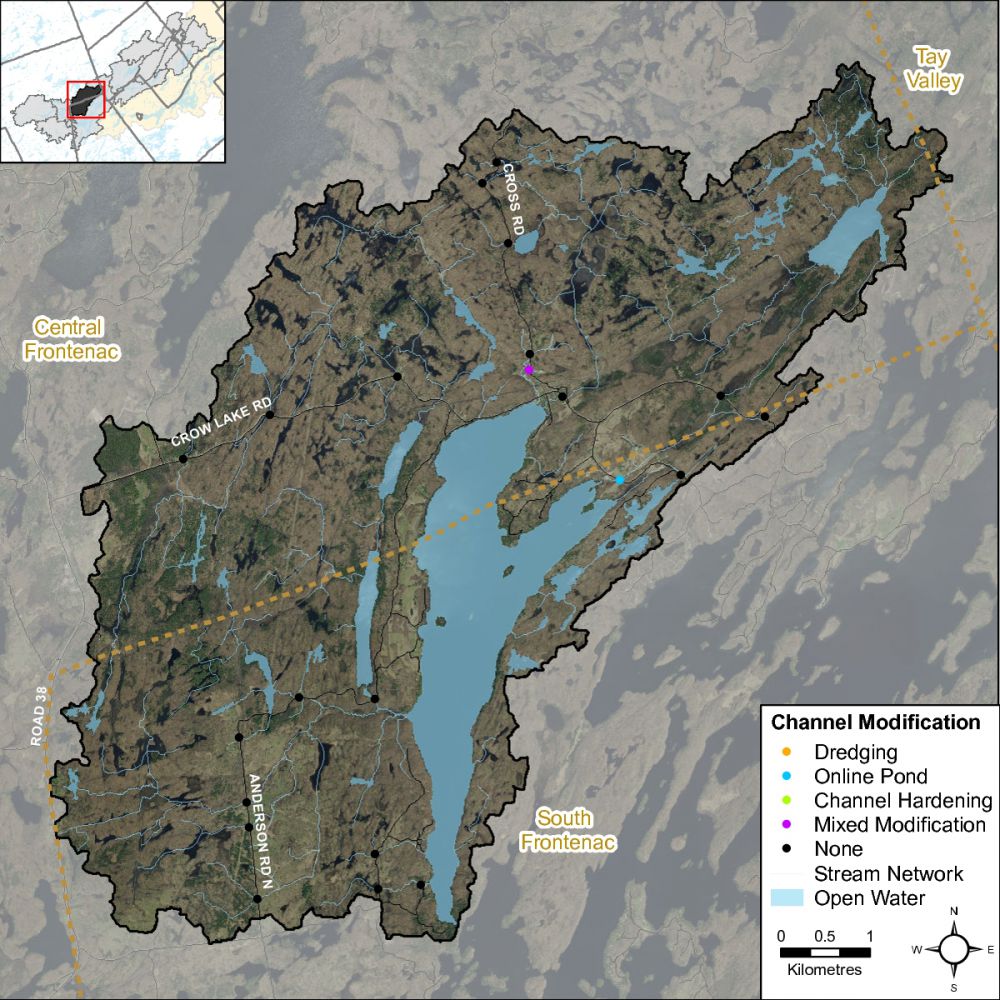
3.3.5 Headwater Feature Vegetation
Headwater feature vegetation evaluates the type of vegetation that is found within the drainage feature. The type of vegetation within the channel influences the aquatic and terrestrial ecosystem values that the feature provides. For some types of headwater features the vegetation within the feature plays a very important role in flow and sediment movement and provides wildlife habitat. The following classifications are evaluated no vegetation, lawn, wetland, meadow, scrubland and forest. Figure 116 depicts the dominant vegetation observed at the sampled headwater sites in the Crow Lake catchment.
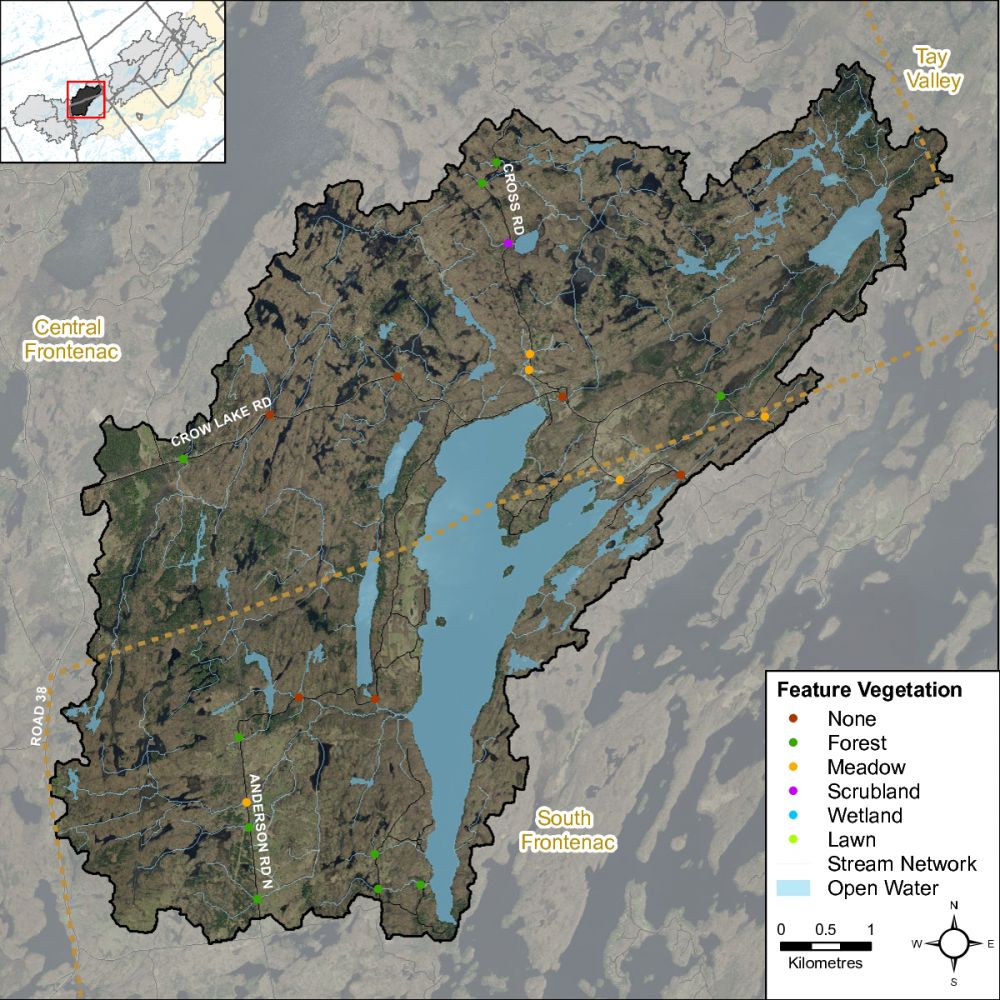
3.3.6 Headwater Feature Riparian Vegetation
Headwater riparian vegetation evaluates the type of vegetation that is found along the adjacent lands of a headwater drainage feature. The type of vegetation within the riparian corridor influences the aquatic and terrestrial ecosystem values that the feature provides to the watershed. Figure 117 depicts the type of riparian vegetation observed at the sampled headwater sites in the Crow Lake catchment. The majority of the headwater drainage features are classified as having natural riparian vegetation with only four features having altered vegetation typically in the form of ornamental grass or agricultural crops in the riparian zone.
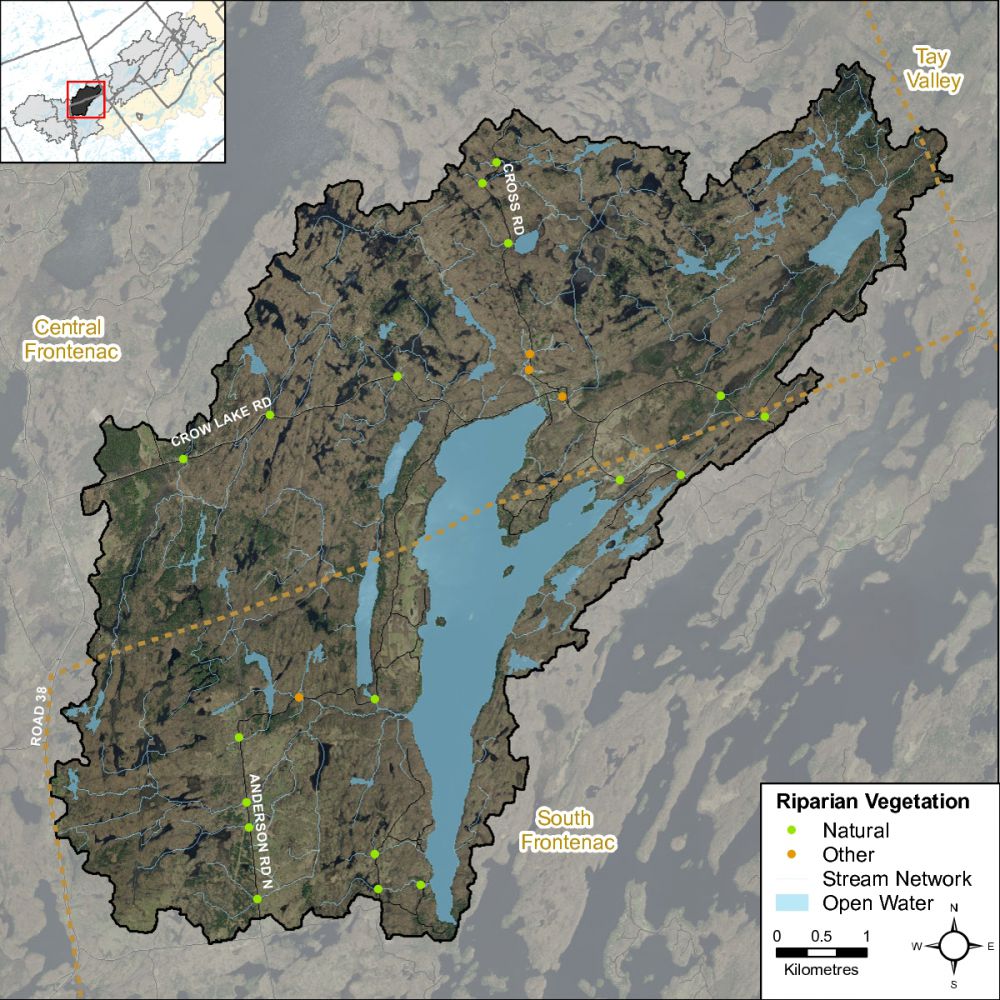
3.3.7 Headwater Feature Sediment Deposition
Assessing the amount of recent sediment deposited in a channel provides an index of the degree to which the feature could be transporting sediment to downstream reaches (OSAP, 2013). Evidence of excessive sediment deposition might indicate the requirement to follow up with more detailed targeted assessments upstream of the site location to identify potential best management practices to be implemented. Sediment deposition ranged from none to substantial for the headwater sites sampled in the Crow Lake catchment area. Figure 118 depicts the degree of sediment deposition observed at the sampled headwater sites in the Crow Lake catchment. Sediment deposition conditions ranged from no sediment deposition to moderate.
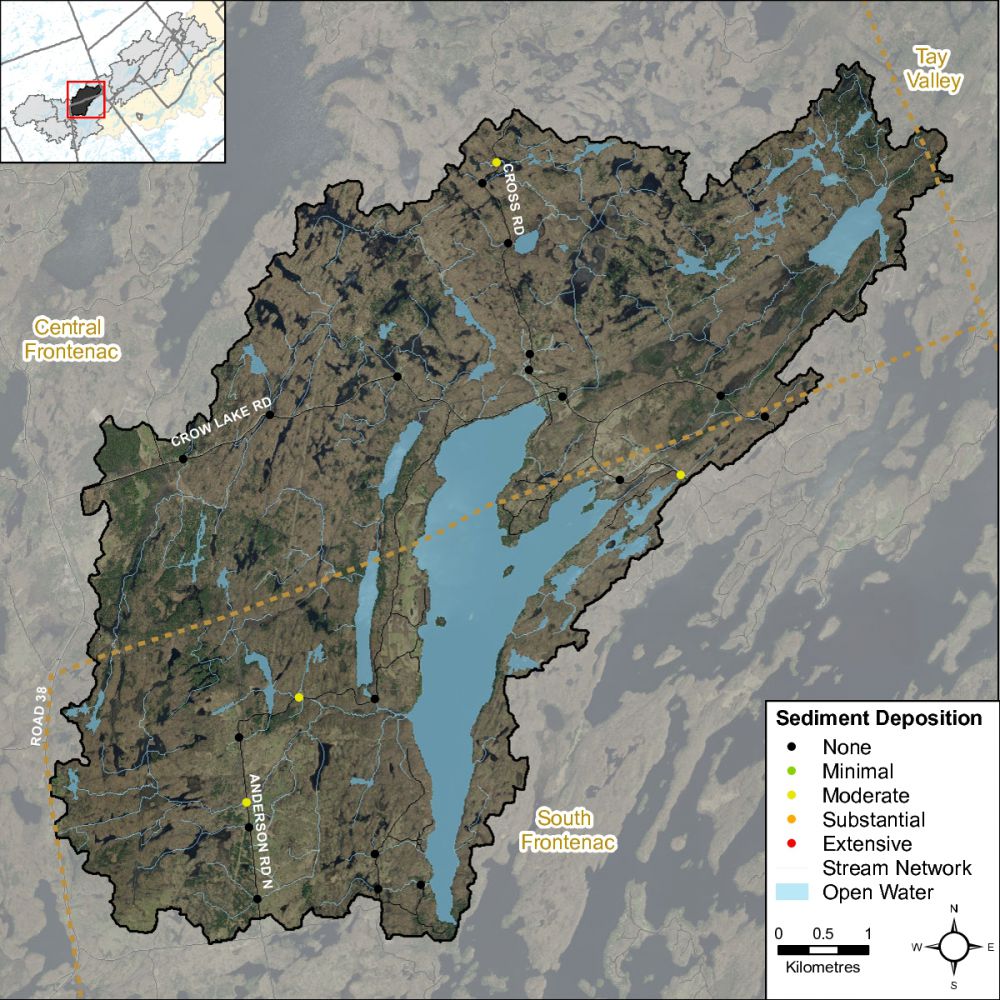
3.3.8 Headwater Feature Upstream Roughness
Feature roughness will provide a measure of the amount of materials within the bankfull channel that could slow down the velocity of water flowing within the headwater feature (OSAP, 2013). Materials on the channel bottom that provide roughness include vegetation, woody Structure and boulders/cobble substrates. Roughness can provide benefits in mitigating downstream erosion on the headwater drainage feature and the receiving watercourse by reducing velocities. Roughness also provides important habitat conditions for aquatic organisms. Figure 119 shows that the feature roughness conditions at the sampling locations in the Crow Lake catchment were highly variable ranging from minimal to extreme.
